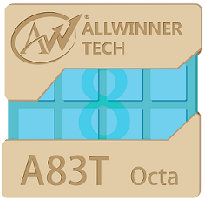 So Allwinner has just announced a new processor. I’ve been disappointed recently when I discovered AllWinner A80 only supports Linux 3.4, whereas most competitors are running Android 3.10 stable kernel, and their partner is distributing A80 OptimusBoard development boards, which looks to be a nice hardware platform, but without any Android or Linux SDK… And with their latest press release you have to wonder… They announced AllWinner A83T processor with “eight highly energy-efficient Cortex-A7 cores that could run simultaneously at around 2.0GHz, and implements the advanced big.LITTLE architecture to maximize the battery life”. The only problem is that with big.LITTLE you need big and LITTLE core, and if AllWinner A83T is just having eight Cortex A7 cores, there’s no big to be found… I guess that just means they can turn cores on and off independently…
So Allwinner has just announced a new processor. I’ve been disappointed recently when I discovered AllWinner A80 only supports Linux 3.4, whereas most competitors are running Android 3.10 stable kernel, and their partner is distributing A80 OptimusBoard development boards, which looks to be a nice hardware platform, but without any Android or Linux SDK… And with their latest press release you have to wonder… They announced AllWinner A83T processor with “eight highly energy-efficient Cortex-A7 cores that could run simultaneously at around 2.0GHz, and implements the advanced big.LITTLE architecture to maximize the battery life”. The only problem is that with big.LITTLE you need big and LITTLE core, and if AllWinner A83T is just having eight Cortex A7 cores, there’s no big to be found… I guess that just means they can turn cores on and off independently…
Allwinner must also have adopted Qualcomm or Mediatek press release “strategy”, as they release a little information as possible for their first press release… So right now, we just know the processor will be manufactured using TSMC’s 28-nm HPC processor, the cores will run up to 2.0 GHz, a PowerVR GPU is part of the mix, and it will feature Allwinner’s SmartColor technology to deliver better image quality.
Tablets based on Allwinner A83T should start selling in Q4 2014.

Jean-Luc started CNX Software in 2010 as a part-time endeavor, before quitting his job as a software engineering manager, and starting to write daily news, and reviews full time later in 2011.
Support CNX Software! Donate via cryptocurrencies, become a Patron on Patreon, or purchase goods on Amazon or Aliexpress




